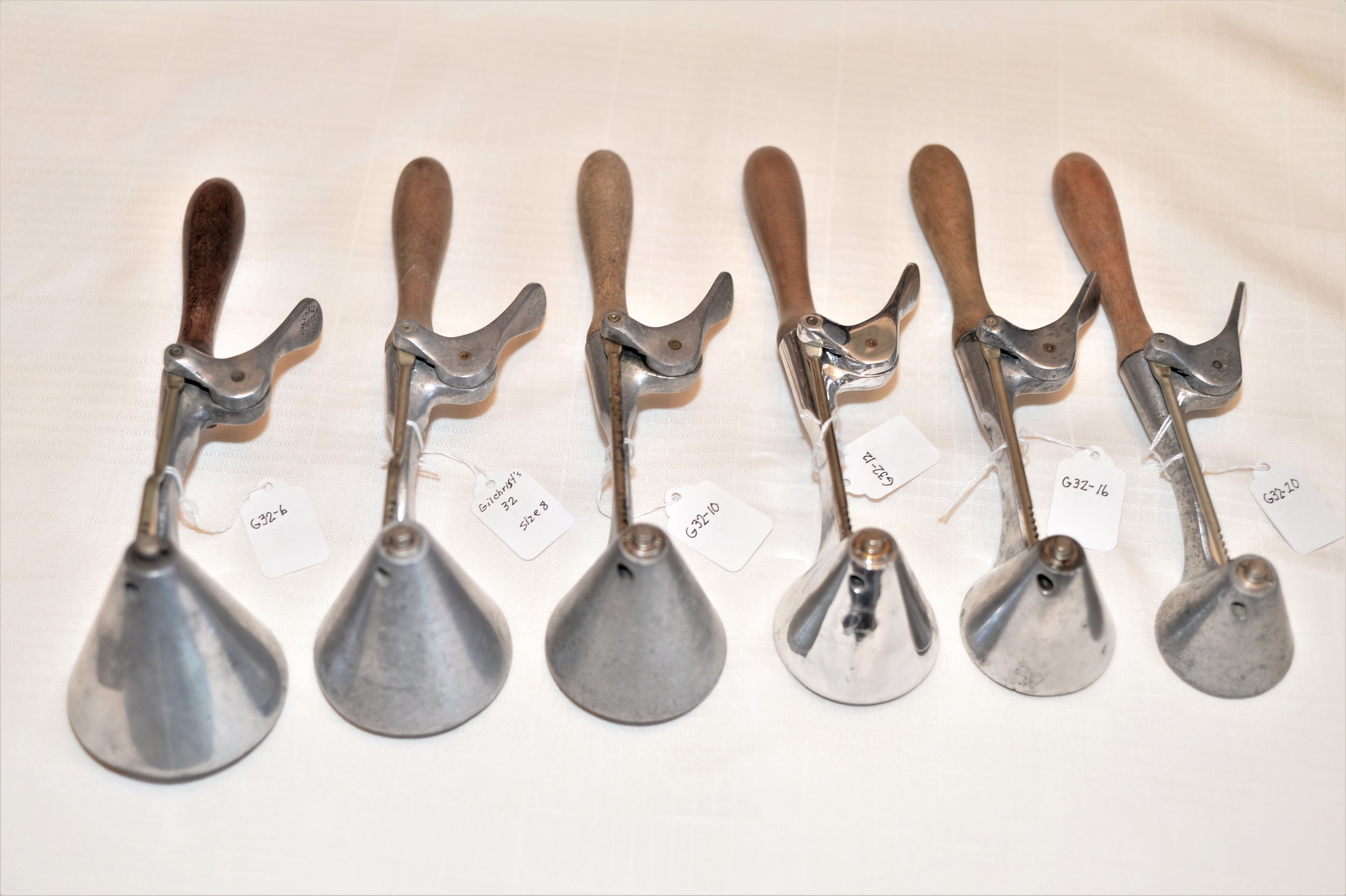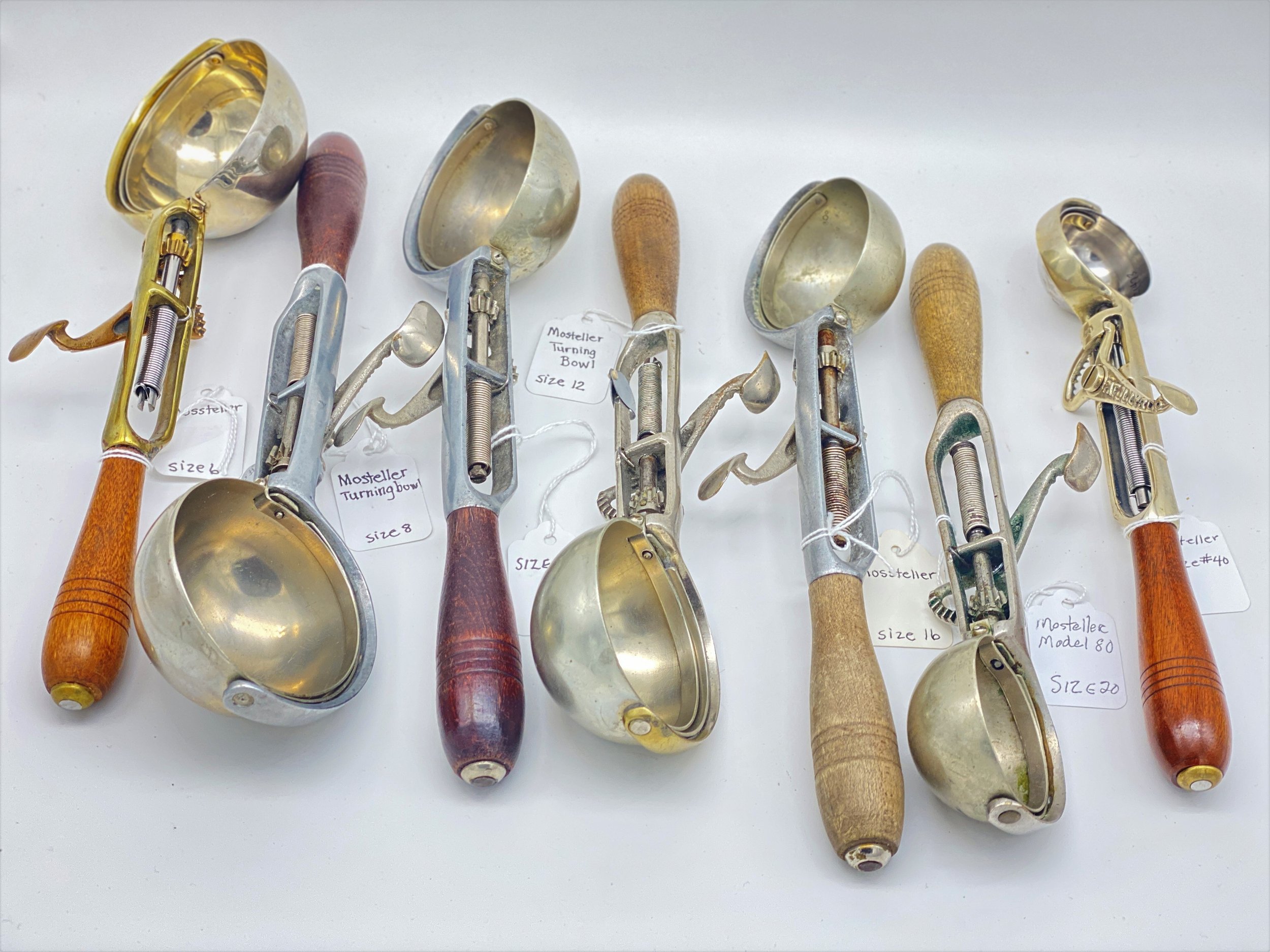Scoop Set Collecting
When I first started with ice cream scoop collecting, I saw what was called a set of Gilchrist Model 31. The set was a group of 9 round bowled scoops in different sizes. I could not comprehend a market that could support this many scoop sizes of the same model. These included sizes 6,8,10,12,16,20,24,30,40, and at this time I didn’t know that there was a banana split scoop made under model number 31. So this was not a full set of scoops labeled as model 31. I was so impressed with this display that I established a goal for my collection to own someday a full set of these Gilchrist model 31 scoops.
As my collection grew and the awe-inspiring image of those G31’s faded just a bit, I still look to each scoop as just one part of a set. Generally, a set is defined as one of each size bowl manufactured for a given model. I also believe that a set should include all variations of a particular model. This self-imposed complexity has been a rewarding approach in that a relativity common scoop can be an exciting discovery should it be a size or variation that’s not currently in our collection.
Bowl sizes and some variation data can be found in several places. Wayne Smith’s book “Ice Cream Dippers” is the best resource that I know. I also find info in manufacturers’ data, distributor catalogs, and various advertisements. With all of this, I still find exceptions, even in bowl sizes. Manufacturing variations are more common than you might imagine in that a change in the thumb operator shape, handle shape and/or material, attachment hardware, even the basic alloy, etc. might change within a given model. This sort of thing was quite common with the Erie Specialty Company. I think these variations were fully intentional from Erie and their “Quick and Easy” models were quite diverse. Smaller manufacturers might produce a variation that was not so intentional. It seems like the “idea of the day” might rule with some and if the inventor and patent owner were to change manufacturing shops, the small details might change. We have a collection of 4 sandwich scoops of the same apparent model all having slightly different attachments at the point where the bowl meets the shaft. The Gilchrist Company was actually quite good at producing a consistent product without manufacturing variation within model numbers. Another variation of note was that some scoops were manufactured for different companies without change to the scoop itself. Maybe a company would be taken over by another, and the manufacturer would just change the company name. Maybe one company would make a scoop model that was then sold into a franchise-type scheme. Mostly, the reasoning behind these variations is unknown to me.
One thing that I have found to be true with set collecting is that it’s difficult to be sure that you ever have a complete set. I assume I will have a set once I have acquired all the bowl sizes and variations I know. In several cases, I later found that I was wrong and that other sizes and or variations do exist. So if you are a set collector, you may never stop looking even if you think that you have them all.
The pictures below are examples of what might be complete sets.
Of course, a complete set of the Gilchrist Model 31’s would include the banana split scoop.
Here is what I believe to be a full set of the Gilchrist model 32s. These are the brothers to the Gilchrist model 33 with the biggest difference being the aluminum alloy in the main parts.
This might be a complete set of Bohlig split bowl scoops. Every resource I have found describes only the size 12,16, and 20. This set also includes a size 8.
A set of Kingery Rapids can be challenging to assemble. As with most models the largest and the smallest are the hardest to find. These handsome scoops patented in 1894 were among the first scoops that could be operated with one hand. The fancy handles shown here are units that were made some 8-10 years after the original release. The first ones had plain handles.
I believe that all of these were made or copied from the same patent design. Note the manufacturing differences.
This scoop is popular with collectors for its exotic design and portion control mechanism. Note the difference in the bowl configuration and the placement in the adjuster device.
Here is a set of the Mosteller turning bowl scoops. Note the size 40 unit on the far right. I don’t believe that this one was manufactured by Mosteller, although it is perfect in every detail.
This set of Dover slicers has dual operating mechanisms. The single-operator model was designed first. Both models were made in the same sizes.
These four sandwich model scoops were all designed by Johannes Schloemer and did approximately the same thing. Notice the differences.








